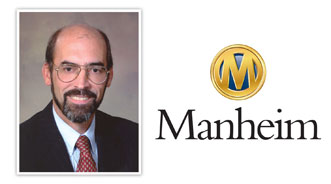Manheim Index Declines Again; Still Much Higher Than Year-Ago Level

Though the July Manheim Used Vehicle Value Index made its steepest decline thus far this year, the reading still represented a 5.9-percent increase from its year-ago level.
Manheim determined this week that between June and July, wholesale used-vehicle prices (on a mix-, mileage-, and seasonally adjusted basis) fell 1.3 percent, leaving July’s index reading at 125.9.
The drop also marked the first time since last summer the Manheim index has dipped for two consecutive months. It’s also the largest decline since the index slid from 124.9 to 123.6 during the first two months of this year.
“The recent decline in wholesale prices is a natural retrenchment from the record high reached in May, which is when new-vehicle inventory shortages were at their worst,” Manheim chief economist Tom Webb explained.
“The fundamental drivers of used vehicle values — lower wholesale supplies and improving retail demand — have not changed. Indeed, retail used-vehicle sales picked up sharply in July,” Webb continued.
Small-Car Pricing Remains Strong
Manheim discovered compact and midsize cars are the only two segments with meaningful gains over the past year. But Webb pointed out it is pickup trucks that have shown the best performance during the past two months.
“Although compact and subcompact vehicles continue to have tight supplies in the new-vehicle market, that situation is expected to change in the months ahead,” Webb surmised. “And, as such, there should be some moderation in pricing.”
Looking strictly year-over-year, Manheim noticed compact cars prices are 16.7 percent higher and midsize car prices are 11.9 percent higher.
Also squeaking out year-over-year price gains were luxury cars (1.1 percent) and vans (0.9 percent).
Despite the recent strengthening Webb mentioned, Manheim determined pickups are still off 1.7 percent.
Manheim indicated year-over-year softening of SUV and CUV prices was even greater. In fact, it was 5.7 percent in July.
Off-Rental: Prices High, Volumes Low
Manheim pointed out the average price of a rental risk unit sold at auction remained above the $14,000 mark for the fifth consecutive month in July. Webb also mentioned average mileage moved down during the month, but it remained above the year-ago level.
“The volume sold during the month declined but at a slower rate than in the first half of the year,” he added.
Commercial Fleet Units: Lower Prices, Lower Volumes
Moving over to commercial fleet, Manheim noticed one trend similar to the off-rental segment but spotted a different trend, too.
After reaching a record high in June, Manheim stated prices for end-of-service midsize fleet cars (mileage and seasonally adjusted) moved lower in July.
“A review of monthly pricing and volumes sold in 2011 suggests that fleet managers were spot-on in remarketing their largest volumes when prices were the highest,” Webb stressed.
New & Used Sales Improve, But More Is Needed
After reviewing wholesale trends, Webb turned his attention to the retail side of the business.
“We earlier contended that anything above 12 million for July’s seasonally adjusted annual rate (SAAR) should be considered a bonus,” Webb offered.
“Thus, we had a bonus with the sales at a 12.2 million SAAR,” he continued. “The feat is all that more impressive given the economic conditions and uncertainty that gripped both consumers and businesses.
“But, by the same token, that economic backdrop suggests that the return to a 13 million SAAR may be pushed further out,” he added.
Moving over to used-vehicle sales, Webb pointed to CNW Research data that revealed July’s level was 13.5 percent higher year-over-year, a jump the Manheim economist relayed as “blockbuster.”
Webb also referenced TrueCar.com, which reported on July 28 that it expected July used-vehicle sales would be up only 2.3 percent.
“But then, TrueCar also estimated that the new vehicle SAAR would be only 11.4 million,” Webb pointed out.
“In any event, both firms said that used-vehicle sales topped the 4 million mark in July,” he continued. “As with the new-vehicle sales rate in July, it should be remembered that the month had five weekends this year, which normally boosts the sales tally.
“Nevertheless, given the exceptional weakness in overall consumer spending in the second quarter (a trend that continued into July), the ability of dealers to grow used unit volumes has been noteworthy,” Webb went on to say.
The July index reading came a week after Manheim released its Used Market Report — Mid-Year Edition. Auto Remarketing and sister publication, SubPrime Auto Finance News, shared much of Webb’s analysis.
—Manheim Reveals Mid-Year Trends and Key to Remarketing Resurgence
—Manheim: Wholesale Price Conditions Hit BHPH Dealers Hard & More Financing Trends Revealed

 View The Latest Edition
View The Latest Edition

